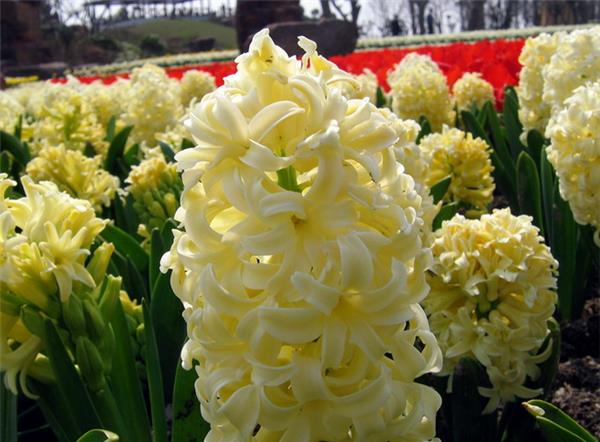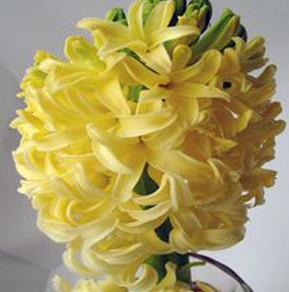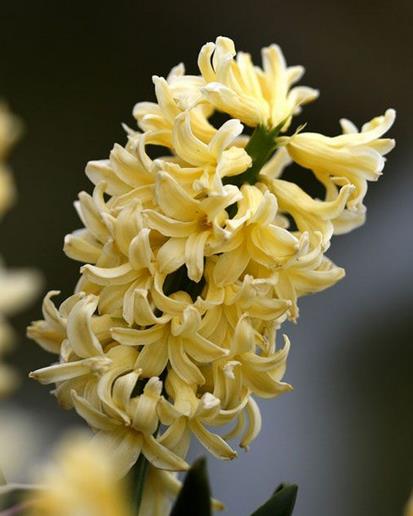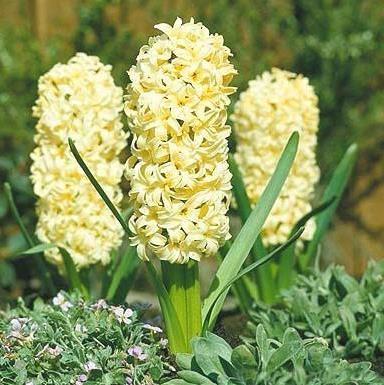A detailed introduction to the flower language of yellow hyacinth
A detailed introduction to the flower language of yellow hyacinth

Yellow hyacinth, which is an aristocratic species in the hyacinth family, is often used in the West to send lovers, representing happiness with you. It's like people are happy with Apollo, the sun god, and happy with you.
A detailed introduction of yellow hyacinth
Hyacinth, its English name is: Hyacinth, when speaking the flower language of yellow hyacinth, let's first understand the origin of the scientific name of hyacinth: it is said that the scientific name of hyacinth comes from the Greek mythology of Yacintos, because his name is Hyacinthus, and people use hyacinth to name this popular flower at that time in memory of the sun god Apollo.
Hyacinths of different colors have different fancy words:
Hyacinth: miss it forever. As long as you light the fire of life, you can share the rich life hyacinth; purple hyacinth: sad, melancholy love. Apology, regret. (get my love, you will be happy) lavender hyacinth: gentle temperament, romantic feelings. Sadness.
White hyacinth: secret love. Love that is pure, light or afraid to show.
Red hyacinth: thank you, touching love (your love fills my heart) Peach hyacinth: represents enthusiasm, pink hyacinth: admiration, romance.

Yellow hyacinth: I am very happy with you.
Blue hyacinth: noble and rich, perseverance, chastity, as happy as to see you.
Dark blue hyacinth: a little melancholy because of love
Light green hyacinth: if you want to have no secrets, you must first have a kind heart.
The breeding methods of yellow hyacinth should pay attention to the following aspects:
Bulb selection: hyacinth flowers need nutrients, mainly depends on the supply of nutrients stored in the bulbs and leaves, as long as choose no damage to the epidermis, fleshy scales do not wrinkle, strong and extremely heavy, plump bulbs, in order to produce thick and magnificent flowers.
Open field cultivation should be carried out from October to November, select the soil with good drainage, apply sufficient base fertilizer before planting, cultivate in the field, avoid continuous cropping, generally do not make other management before flowering, and if you do not plan to harvest seeds after flowering, the flower stem should be cut off to promote the development of bulbous roots. the cutting position should be at the top of the flower stem as far as possible. The bulb root can be dug up in early June, spread out, graded storage in the cold storage, summer temperature should not exceed 28 degrees Celsius.
Potted plants: hyacinth bulbs selected from the market at the end of autumn and planted in loose culture soil. Use loam, rotten leaf soil, fine sand and other mixed and cooperative nutrition. Attention should be paid when planting: the upper end of the bulb should be exposed to the basin soil, should be placed in the sun after planting, and should keep the basin soil moist. The temperature required to promote flowering is 5: 10 ℃.
Hydroponic cultivation: you can choose glassware whose mouth is slightly smaller than the bulb, put the bulb on the mouth of the bottle, add water to about 1 cm away from the bulb plate, or like daffodils, several bulbs can be planted together in a shallow basin for hydroponic culture. Promoting cultivation: after the end of the month, the bulbs were treated with 8C for 75 days, then potted in early October and cultivated in the greenhouse to make them blossom at the end of the year. As the sensitivity of cultivated varieties varies greatly, the varieties suitable for promoting cultivation should be selected when promoting cultivation.

Notes on the cultivation of yellow hyacinth:
Hyacinth is native to southern Europe, the eastern Mediterranean coast and Asia minor. Like cool, moist air, sunny environment, cold resistance, requires good drainage of sandy soil, low wet viscous soil growth is very poor. Hyacinth likes fertilizer, whether potted or planted on the ground, it is best to apply sufficient basic fertilizer, the soil should be loose, often topdressing during the growth period. Loosen the soil in time after seedling emergence, apply fertilizer once in winter, and fertilize again before and after flowering in spring. Potted plants promoted the cultivation of balls in September, with 4 plants per pot. Put in the sun, move into the greenhouse in November, and the Spring Festival can blossom. When hyacinth promotes cultivation, be sure to grow roots without leaves at a lower temperature, and then grow leaves at a certain height in a semi-shade and slightly higher temperature, and finally give higher temperature and sufficient sunlight, so that the stems and leaves can be full. flowers are luxuriant. Hyacinth propagates mainly by dividing balls. After the aboveground parts die in summer, the bulbs are dug out and the bulbs are separated from the bulbs. The bulbs need to be cultivated for three years before they can bloom. In order to cultivate new varieties, it can also be sown and propagated. It takes 5 years for seedlings to blossom. The hyacinth plant is short, the inflorescence is neat and strange, and the color is cold and colourful. Potted plants, put indoors to enjoy. Hyacinth can be cultivated by hydroponics. The flowering plants are moved into special-shaped glassware and water is added. The flowers, leaves and roots can be appreciated, elegant and clean, and can be placed anywhere in the room.

Water: keep the plant moist during growth and flowering. The humidity of the air in the general room is fine.
Fertilizer: there is no need to apply fertilizer during flowering. Topdressing can be applied once before and after flowering, and sufficient basal fertilizer can be applied during cultivation.
Soil: should be well drained, fertile sandy loam. Avoid sticky soil, or cultivate it with hydroponics.
Wen: resistant to cold.
Light: florescence indoor is more durable, if possible, it is best to have 4 hours a day in front of brightly lit south, east and west windows.
Hyacinth habits like the sun, cold-resistant, suitable for growing in a cool and humid environment and loose, fertile sandy soil, avoid stagnant water.

Is the yellow hyacinth poisonous?
Although hyacinth is good-looking, it is really poisonous, so it can't be put in the bedroom, it should be put in a well-ventilated place. And hyacinth pollen is easy to cause skin allergy, so you should avoid smelling flowers near your nose. Don't worry too much if you put it on the living room table. In addition, hyacinth bulbs are also toxic, if accidental eating will cause dizziness, stomach cramps, diarrhea and other symptoms, serious can lead to paralysis and fatal.
Water: keep the plant moist during growth and flowering. The humidity of the air in the general room is fine.
Fertilizer: there is no need to apply fertilizer during flowering. Topdressing can be applied once before and after flowering, and sufficient basal fertilizer can be applied during cultivation.
Soil: should be well drained, fertile sandy loam. Avoid sticky soil, or cultivate it with hydroponics.
Wen: resistant to cold.
Light: florescence indoor is more durable, if possible, it is best to have 4 hours a day in front of brightly lit south, east and west windows.
Hyacinth habits like the sun, cold-resistant, suitable for growing in a cool and humid environment and loose, fertile sandy soil, avoid stagnant water.

Is the yellow hyacinth poisonous?
Although hyacinth is good-looking, it is really poisonous, so it can't be put in the bedroom, it should be put in a well-ventilated place. And hyacinth pollen is easy to cause skin allergy, so you should avoid smelling flowers near your nose. Don't worry too much if you put it on the living room table. In addition, hyacinth bulbs are also toxic, if accidental eating will cause dizziness, stomach cramps, diarrhea and other symptoms, serious can lead to paralysis and fatal.
Related
- Wuhan Hospital Iron Tree Blooming Result Was Instantly Frightened by the Gardener Master
- Which variety of camellia is the most fragrant and best? Which one do you like best?
- What is the small blue coat, the breeding methods and matters needing attention of the succulent plant
- Dormancy time and maintenance management of succulent plants during dormancy
- Minas succulent how to raise, Minas succulent plant pictures
- What are the varieties of winter succulent plants
- How to raise succulent plants in twelve rolls? let's take a look at some experience of breeding twelve rolls.
- Attention should be paid to water control for succulent plants during dormant period (winter and summer)
- Watering experience of twelve rolls of succulent plants
- Techniques for fertilizing succulent plants. An article will let you know how to fertilize succulent plants.



